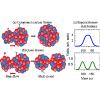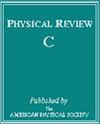慢准裂变中壳效应的实验证据
IF 3.4
2区 物理与天体物理
Q1 Physics and Astronomy
引用次数: 0
摘要
通过将几个反应的测量数据与理论进行比较,得出了慢准裂变(SQF)过程产生的裂变碎片的质量分布,显示出明显的特征。无论裂变体系如何,在 SQF 质量分布中,与较轻碎片相对应的峰值始终位于 A≈96,而较重碎片的峰值位置则随着二核体系质量的增加而线性增加。此外,准裂变事件的产率随着射弹能量的增加而降低。这些与模型相关的观测结果清楚地证明了慢速类裂变中的壳效应,其中较轻的碎片可能是质量区 A≈96 的一些闭壳核(可能是 Zr96 或 Sr94)。此外,与模型无关的多高斯拟合高能数据点的结果再次证实了上述结论。本文章由计算机程序翻译,如有差异,请以英文原文为准。

Experimental evidence of shell effects in slow quasifission
Mass distributions of fission fragments arising from the slow quasifission (SQF) process, derived by comparing the measured data with theory for several reactions, show distinct features. Irrespective of fissioning systems, the peak corresponding to lighter fragments in the SQF mass distribution is found to be always at , whereas the peak position of the heavier fragments increases linearly with the mass of the dinuclear system. Further, the yield of quasifission events decreases with the increasing projectile energy. These observations within certain model dependence provide clear evidences of shell effect in slow quasifission, where the lighter fragments are possibly some closed-shell nuclei in the mass region (possibly or ). Further, the results from a model independent approach involving multi-Gaussian fit to the high energy data points reaffirm the above conclusion.
求助全文
通过发布文献求助,成功后即可免费获取论文全文。
去求助
来源期刊

Physical Review C
物理-物理:核物理
CiteScore
5.70
自引率
35.50%
发文量
0
审稿时长
1-2 weeks
期刊介绍:
Physical Review C (PRC) is a leading journal in theoretical and experimental nuclear physics, publishing more than two-thirds of the research literature in the field.
PRC covers experimental and theoretical results in all aspects of nuclear physics, including:
Nucleon-nucleon interaction, few-body systems
Nuclear structure
Nuclear reactions
Relativistic nuclear collisions
Hadronic physics and QCD
Electroweak interaction, symmetries
Nuclear astrophysics
 求助内容:
求助内容: 应助结果提醒方式:
应助结果提醒方式:


